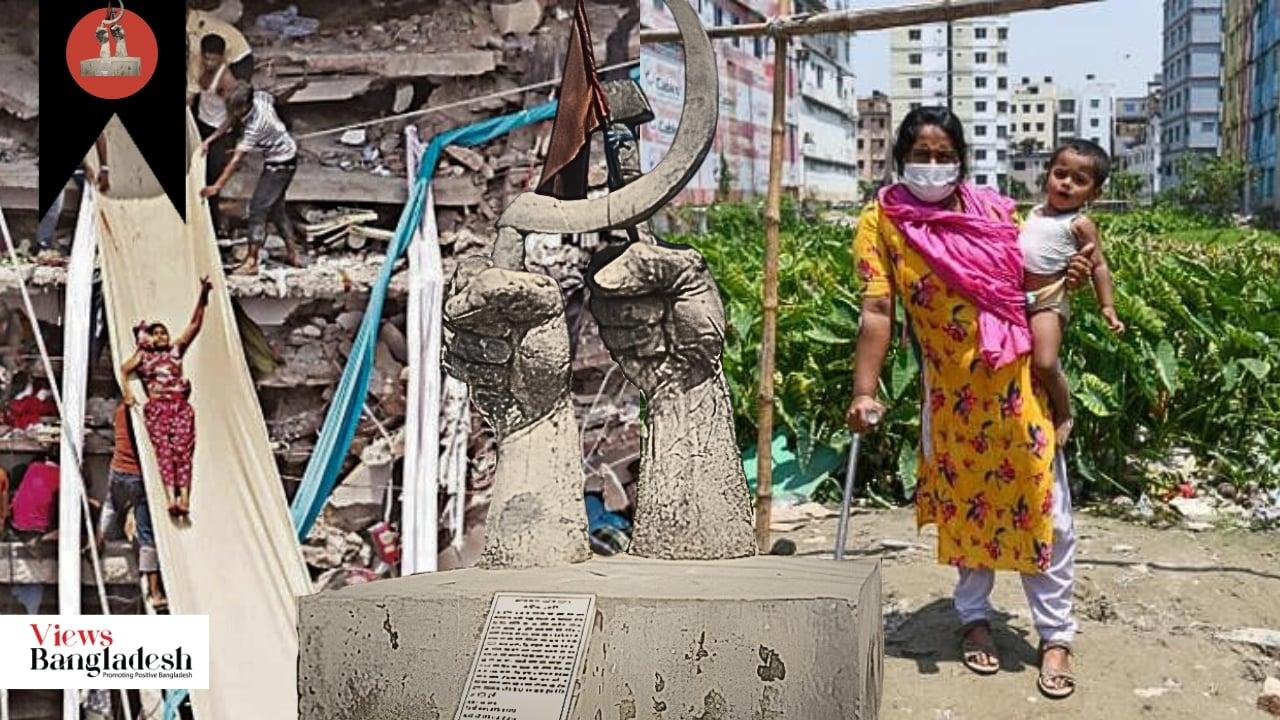11 years of Rana Plaza collapse
Brutal testimony of deadly disaster

The year, 2013, was very turbulent in the history of Bangladesh politics. At that time, the trial of crimes against humanity during the 1971 Liberation War was going on in the country which disturbed the members of Jamaat-e-Islami. Jamaat along with its student wing Chhatra Shibir was continuing a series of violent programmes protesting the trial. It was in the context of this trial that 'Gonojagoron Mancha' (mass-upsurge stage) emerged at the beginning of the year. Meanwhile, ahead of the national elections, the movement to restore the caretaker government was going on under the banner of the 18-party alliance led by the BNP.
Apart from this, radical Islamic outfit Hefazat e Islam staged their biggest rally in Dhaka on April 6, 2013. According to the demands of the organization, the Hathajari-based party of Chittagong has threatened the government by presenting 13-point demands including the execution of atheist bloggers, and the implementation of blasphemy law. In the last week of April of that year, Savar's Rana Plaza became the main focus of mass media around the world, including Bangladesh.
April 24 was a Wednesday in 2013. The day was fixed for the oath-taking ceremony of the 20th President of Bangladesh, Abdul Hamid. He was set to take oath at Bangabhaban in the afternoon. But before his oath, Savar, a suburb of Dhaka, grabbed the attention of the media. I was working as a senior reporter in ATN Bangla then. April 24 was the second day of the 36-hour strike by the 18-party alliance. In the morning I had the hartal duty. I was usually assigned to cover Mohakhali and Titumir College's adjacent areas during the strike. I went to Titumir College that morning. Mahmudur Rahman, chief reporter of ATN Bangla, called me around 9:30 am and asked, "Where are you?" I said that I was in front of Titumir College. He ordered me to go to Savar at once. He told me that a building collapsed there and many people died.
I arrived in front of the ruins of Rana Plaza in Savar through Gabtali. It was around 10:30 am. What I saw as I passed the area and the people, was a horrible sight. I saw only a random pile of concrete. Army personnel, police, and amateur volunteers have started the rescue work. The injured are being rescued and sent to Enam Medical College Hospital. After collecting information from various people, I came to know that the name of this 10-storey building is Rana Plaza. The building collapsed at 8:47 am. Five garment factories were located in this building. The building was completely unplanned and undesigned which had 270 shops and some private bank branches.
Thousands of people worked in these organizations and the building collapsed completely in just 3-4 seconds. Thousands of fresh souls were trapped inside. On further investigation, I learned that the building had developed cracks the day before, which scared the workers. They refused to work. But the owner of the building, Jubo League leader Sohel Rana forced the workers to join the work giving them false assurance. Upazila Nirbahi Officer Kabir Hossain Sardar also announced that the building is completely safe. He said 'Cracks are nothing unusual.' But alas! On the morning of April 24, the building turned into a death pit, which is still the worst industrial accident or disaster in the history of the world, leaving 1,135 workers dead. More than 3,000 people were injured and many were maimed.
I returned to the ATN Bangla office in Karwan Bazar with photos of the wreckage, vox pop, and other data. After submitting everything, l went to my Mohammadpur house with dust all over my body. I took a bath and sat in front of the television again. Along with local stations, BBC, CNN, and Al-Jazeera, all international TV stations were covering the Rana Plaza disaster.
I was single in 2013. I used to live in Mohammadpur with two journalist-classmates of Prothom Alo. In the evening, I again got a call from the office and went to the spot to cover the night shift. After midnight, I reached again in front of Rana Plaza. In the last 12-15 hours, the severity of this building collapse has become clear in front of everyone. The cry of the trapped people was unbearable. Attempts were being made to rescue those trapped by digging holes through the collapsed roof. But most of the rescuers were amateurs, ordinary people. Ignoring the intense heat of Baisakh, they were desperately trying to rescue the trapped people at the risk of their lives.
The bodies of those killed in the Rana Plaza collapse were taken to Adharchandra Model High School grounds. I went to that field after 2 am. There is also a huge crowd. A small blue pickup and an ambulance were bringing the body. One after another the bodies were coming. Hundreds of people were trying to identify the bodies of their unfortunate relatives. Some were crying out loud. That was a terrible situation and around 4 am, I was quite tired.
At one point, I was thinking that the victims were alive 24 hours ago. They had healthy, normal lives. Perhaps at this time last night, many were in the warm embrace of a husband or wife; but now they are dead. For no reason, their bodies are bruised by the negligence of others. The pressure of the concrete forced the vital air out in agony. Aha! What a tragic, cruel death! How unfortunate are these workers! After gathering the news, I returned to the office in the early morning. I was tired and depressed.
I logged in on Facebook while writing news at the office. My Facebook feed was full of mourning. I saw several news of the rescue operation. But one piece of news surprised and angered me. Mohiuddin Khan Alamgir was the Home Minister of the government at that time. He told BBC Bangla about the collapse of the building, "He came to know that some hartal supporters have shaken on the pillars and gates of the building which could also be a possible reason behind the collapse of the building."
I couldn't believe what he said. Then I listen to BBC news online. I was surprised. I was at a loss as to how a grown man, a minister, could say such things. I returned home with a heart of despair and depression.
Author: Assistant Professor, Department of Mass Communication and Journalism, Jagannath University.


Leave A Comment
You need login first to leave a comment